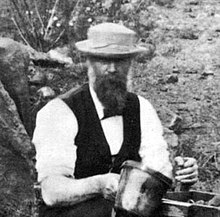Carleton Watkins
| Carleton Watkins | |
|---|---|

self-portrait (enlarged to show detail)
|
|
| Born | November 11, 1829 |
| Died | June 23, 1916 |
| Citizenship | American |
Carleton Watkins (1829–1916) was an American photographer of the 19th century. Born in New York, he moved to California and quickly became interested in photography. He focused mainly on landscape photography, and Yosemite Valley was a favorite subject of his. His photographs of the valley significantly influenced the United States Congress’ decision to preserve it as a National Park.
Watkins was born on November 11, 1829, the eldest of eight children. His parents were John and Julia Watkins, a carpenter and an innkeeper. Born in Oneonta, New York, he was a hunter and fisherman and was involved in the glee club and Presbyterian Church Choir.
In 1851, Watkins and his childhood friend Collis Huntington moved to San Francisco with hopes of finding gold. Although they did not succeed in this specific venture, both became successful. Watkins became known for his photography skills, and Huntington became one of the “Big Four” owners of the Central Pacific Railroad. This would later be helpful for Watkins.
During the first two years in San Francisco, Watkins did not work in photography. He originally worked for his friend Huntington, delivering supplies to mining operations. He did this before working as a store clerk at a George Murray’s Bookstore, near the studio of Robert H. Vance, a well-known Daguerreotypist. An employee of Vance’s unexpectedly left his job, and Watkins’ agreeable personality led to his looking after the studio.
Before his work with Vance, Watkins knew nothing about photography. Vance showed him the basic elements of photography, planning to return and retake the portraits himself. However, when he came back, he found that Watkins had excelled at the art while he was away and his customers were satisfied.
By 1858, Watkins was ready to begin his own photography business. He did many commissions, including “Illustrated California Magazine” for James Mason Hutchings and the documentation of John and Jessie Fremont’s mining estate in Mariposa. He made Daguerreotype stereoviews (two nearly identical images of the same scene, viewed through a stereoscope to create an illusion of depth) at the “Almaden Quicksilver Mines.” These were used in a widely publicized court case, which furthered his reputation as a photographer.
...
Wikipedia
